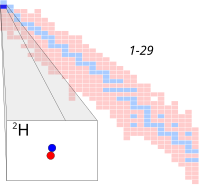
Photo from wikipedia
A zero-dimensional model (perfectly-stirred reactor) in conjunction with CHEMKIN II and a scheme resulting from the merging of validated kinetic schemes for the oxidation of benzene were used to investigate… Click to show full abstract
A zero-dimensional model (perfectly-stirred reactor) in conjunction with CHEMKIN II and a scheme resulting from the merging of validated kinetic schemes for the oxidation of benzene were used to investigate the effect of hydrogen addition on the formation-depletion of C2H2, which is known as a soot precursor. The current modeling study treats the dependence of acetylene amounts on hydrogen percentage in the fuel mixture, and defines the key reaction mechanisms responsible for the observed reduction in C2H2 and consequently in polycyclic aromatic hydrocarbons and soot amounts induced by the hydrogen additive. The main objective of this work was to obtain fundamental understanding of the mechanisms, through which the hydrogen affects the acetylene yields. It was found that, at high temperatures hydrogen/benzene fuel mixtures displayed lower acetylene concentrations compared to the pure benzene fuel, whereas opposite trends were observed at low reaction temperatures.
Journal Title: Kinetics and Catalysis
Year Published: 2017
Link to full text (if available)
Share on Social Media: Sign Up to like & get
recommendations!